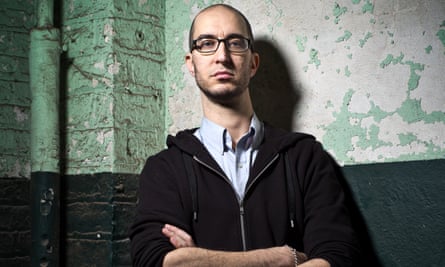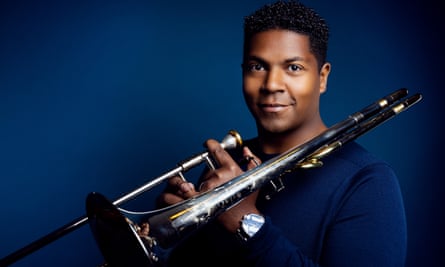Most jazz artists have what could be called the Big Band Dream. That dream is to lead between 12 and 20 musicians, comprising a rhythm section (piano, bass, drums and, sometimes, guitar), as well as trombones, trumpets and woodwinds. Together they make a mighty sound. A big band, or jazz orchestra, serves no small amount of ambition.
“It’s always been a format that I was excited by, because it’s a challenge and inspiring to work with so many instruments,” says US saxophonist Steve Lehman. He recently collaborated with France’s 17-strong Orchestre National de Jazz to create one of 2023’s most adventurous releases, Ex Machina, a mesmerising album that deftly combines acoustic timbres with glitchy, computer-generated noise.
Los Angeles-based Lehman is not the only contemporary composer-improviser making remarkable music with a big band. His compatriots, Henry Threadgill, Maria Schneider and John Hollenbeck all use it with daring wit, as do Dafnis Prieto, who is Cuban American, and Darcy James Argue and Daniel Hersog, both from Canada. Mats Gustafsson, from Sweden, leads the aptly named Fire! Orchestra, while there are enduring some ensembles that have earned seminal status. The Sun Ra Arkestra continues to bring its cosmic vision and dazzling costumes to the world after nearly seven decades, and Gary Crosby’s Jazz Jamaica cooks up a massive, danceable sound from the roots of reggae and ska.
Big bands thus remain an integral fixture on the international jazz landscape, a common thread across cultures. Above all, they big bands appeal to forward-thinking composers because of their rich harmonic palette, which, in the hands of Lehman, is further enhanced by the wily use of cutting-edge technology, creating a place where tradition meets modernity. “You have all those different voices, different colours that can be so detailed, and we also have the electronic component to reinforce the implications of some of those colours,” Lehman says of Ex Machina. “It’s an interesting balance. With a big band the emphasis shifts. It’s more of a collective effort, with a spotlight on different players.”
Another outstanding 2023 orchestral album is Kemet (The Black Land) by USAmerican trombonist-composer Javier Nero. Featuring the excellent vocalist Christie Dashiell, the music, which is based on a strong Afrocentric premise, shows how engrossing the blues can be in a sophisticated, at times densely layered, setting. “[A big band] allows my music to reach the highest and lowest extremes dynamically,” says Nero, “and also allows me to expand the compositions in ways that would be too demanding or challenging in a smaller group setting.”
The big band has deep historical roots. The first iterations were the syncopated orchestras led by visionary African Americans such as Will Marion Cook and James Reese Europe in the early 1900s. By the 1930s, star bandleaders Count Basie, Benny Goodman and Duke Ellington made big bands big business. Fifteen men in sharply tailored suits playing to packed dancehalls became a key image of the “swing” era. However, the mid-40s saw the “small group”, namely quartets and quintets, come to the fore, as Dizzy Gillespie and Charlie Parker made the spiky new sound of bebop a key evolution in jazz. Big bands were also prohibitively costly, one factor that remains an issue today.
“The economics of it are really crushing,” says Lehman with a deep sigh. “It’s so difficult to keep a big band together, maintain it, have everybody sort of treated correctly, and have the financial resources to make a big band recording.”

Nero agrees. “Aside from having to write all of the music, print all of the music and book all of the musicians, the musicians themselves have to be willing to sacrifice the pay in order to be part of it,” he says. “Most venues don’t set aside extra funds to pay an 18-piece jazz orchestra more than a quartet, so it usually just means the same pay divided more times. I’ve been fortunate to find musicians that love playing enough they are willing to participate despite the low pay.”
after newsletter promotion
Regardless of the obstacles, the big band has never been completely derailed. Often it serves as a kind of mothership from which satellites emerge. For close to a decade the British trumpeter Mark Kavuma has led an ensemble called the Banger Factory that has anything up to 15 players but also scales down to a sextet, quintet or duo for specific projects. “We’re moving between big bands and small groups, and I think that’s the model now,” Kavuma says. “What also makes it interesting is that you can have a sound, a consistent sound, because a lot of the people have a creative relationship. People are connected even though the small group and big band stuff might be two different things. It’s really a community we’ve got.”
That sense of togetherness, if not democracy, is exactly what Nero finds most appealing about a big band, musical possibilities aside. “I like the use of big band in education because it teaches a musician to be a team player, and forces students to socialise and communicate with each other,” he says. “The big band is a microcosm for all of our western societal values. When it’s working correctly, veryone feels like they play an important role. They feel good about others’ success.”

